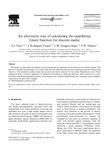
Please use this identifier to cite or link to this item:
http://ricaxcan.uaz.edu.mx/jspui/handle/20.500.11845/629Full metadata record
| DC Field | Value | Language |
|---|---|---|
| dc.contributor | 39945 | es_ES |
| dc.contributor.other | https://orcid.org/0000-0003-0087-8991 | - |
| dc.coverage.spatial | Global | es_ES |
| dc.creator | Vlaev, Stoyan | - |
| dc.creator | Rodríguez Vargas, Isaac | - |
| dc.creator | Gaggero Sager, Luís Manuel | - |
| dc.creator | Velasco, Víctor | - |
| dc.date.accessioned | 2018-08-13T16:08:54Z | - |
| dc.date.available | 2018-08-13T16:08:54Z | - |
| dc.date.issued | 2004-04 | - |
| dc.identifier | info:eu-repo/semantics/publishedVersion | es_ES |
| dc.identifier.issn | 0039-6028 | es_ES |
| dc.identifier.uri | http://hdl.handle.net/20.500.11845/629 | - |
| dc.identifier.uri | https://doi.org/10.48779/yd0p-3v88 | - |
| dc.description.abstract | We present an alternative and efficient way for calculating the superlattice Green function for discrete systems. Theidea is to consider the superlattices as a crystal with the unit cell having the size of the superlattice period in the growthdirection. The calculation method takes into account the matrix structure of the system Hamiltonian and a block tridiagonal matrix inversion algorithm. To illustrate the method we study the electronic band structure of a semiconductor superlattice described by means of an empirical sp3s tight-binding Hamiltonian, including nearest-neighbor interactions and spin–orbit coupling. | es_ES |
| dc.language.iso | eng | es_ES |
| dc.publisher | Elsevier | es_ES |
| dc.relation | https://www.sciencedirect.com/science/article/pii/S0039602804001402?via%3Dihub | es_ES |
| dc.relation.uri | generalPublic | es_ES |
| dc.rights | Atribución-NoComercial-CompartirIgual 3.0 Estados Unidos de América | * |
| dc.rights.uri | http://creativecommons.org/licenses/by-nc-sa/3.0/us/ | * |
| dc.source | Surface Science, Vol. 554, No 2–3, 10 abril 2004, Pág. 245-252 | es_ES |
| dc.subject.classification | CIENCIAS FISICO MATEMATICAS Y CIENCIAS DE LA TIERRA [1] | es_ES |
| dc.subject.other | Superlattices | es_ES |
| dc.subject.other | Green’s function methods | es_ES |
| dc.subject.other | Surface electronic phenomena (work function, surface potential, surface states, etc.) | es_ES |
| dc.title | An alternative way of calculating the superlattice Green function for discrete media | es_ES |
| dc.type | info:eu-repo/semantics/article | es_ES |
| Appears in Collections: | *Documentos Académicos*-- UA Física | |
Files in This Item:
| File | Description | Size | Format | |
|---|---|---|---|---|
| An alternative way.pdf | 290,34 kB | Adobe PDF |  View/Open |
This item is licensed under a Creative Commons License
